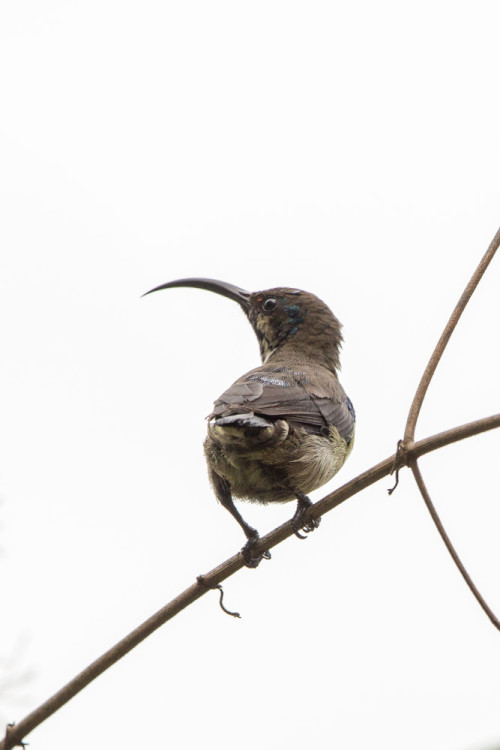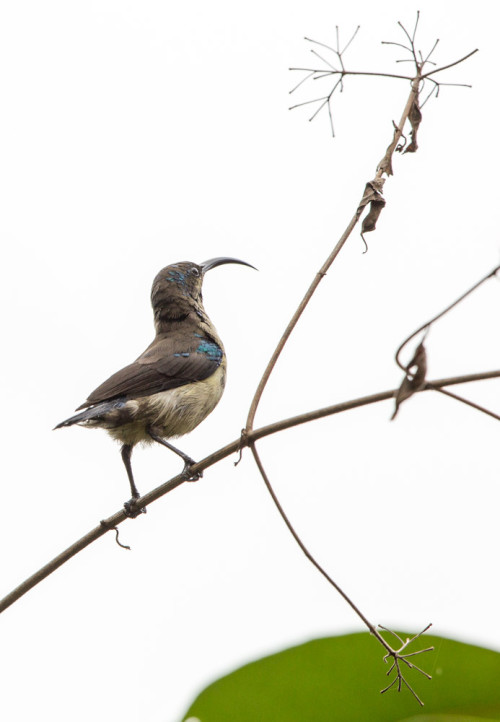
I found this male Loten’s Sunbird Cinnyris lotenius with eclipse plumage at Bondel, Mangalore. The presence of male eclipse phases can be terribly confusing to newcomers but experienced birders generally take them for granted. Now how does the male eclipse comes about? Through moulting of course. After the breeding season the male moults its colourful plumage and take on a less attractive eclipse dress. Once the next breeding season comes, he will again take on his colourful plumage. I photographed it using Canon EOS 5D Mark III using Canon EF 500mm f/4L IS II USM Lens combined with Canon EF 1.4x III Extender. All the photos were shot handheld at 1/800th of second shutter speed at f/8.0 aperture.

The adult male Loten’s Sunbird is mainly glossy purple with a grey-brown belly. It is similar to Purple Sunbird, but is larger, has a longer sickle-shaped bill, and a different belly colour. The eclipse male has yellow-grey upperparts, darker than Purple Sunbird, and a yellow breast with a blue central streak extending to the belly. The female has yellow-grey upperparts and yellowish underparts, but lacks Purple’s faint supercilium.

It is clear that this bird is not a female. Females have plain pale yellow bellies and plain grey-brown backs and wings. This guy has a streak of dark metallic violet from chin to belly. There are also patches and hints of metallic sheen on wings, cheek etc. So what bird is this? This could be a juvenile male who may be transitioning into adult male plumage. this could be a male in eclipse plumage i.e. non-breeding plumage. Even though the existence of such an eclipse plumage in Loten’s Sunbird is debated due to the lack of specimens in evidence, I believe this is an example of eclipse plumage.
The Loten’s Sunbird or otherwise known as Long-billed Sunbird, Cinnyris lotenius is one of a group of very small sunbird which feed largely on nectar. Sunbirds will also take insects, especially when feeding young and Loten’s Sunbird is possibly more insectivorous than other sunbird species. Their flight is fast and direct on their short wings. Long bill separates this from the more common Purple Sunbird (Cinnyris asiaticus). The wings are browner and the maroon breast band is visible on the male under good lighting. The call is distinctive and they are also very active often bobbing their head while foraging. Loten’s Sunbird is found only in peninsular India and Sri Lanka. The main region is along the Western Ghats and into the southern peninsula. There are scattered records from central India and into the northern Eastern Ghats near Orissa. Race hindustanicus is found in India while the nominate race is found in Sri Lanka.

The song of the male is a long repeated wue-wue-wue… with the last notes accelerated. The males may sing from the tops of bare trees or telegraph wires. Loten’s Sunbird is a resident breeder that is locally common in forest and cultivation in south India and Sri Lanka. Two eggs are laid in a suspended nest in a tree. The bag of webs, bark and caterpillar frass. Salim Ali notes that the species is exceptional among Indian sunbirds in not having cobwebs on the exterior.

Loten’s Sunbirds are small, only 12-13 cm long. They have long down-curved bills and brush-tipped tubular tongues, both adaptations to their nectar feeding. The bill lengths vary across populations with long bills found in Sri Lanka.

